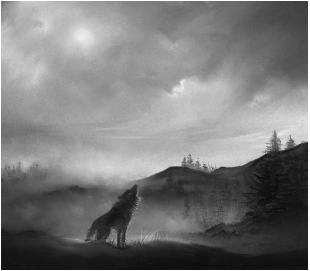Scottish legends: The Cu Sith
By zteve t evans

The Cù-Sìth was a spectral dog found in the mythology of Scotland and the Hebrides. The name comes from Scottish Gaelic. A similar beast exists in Irish mythology, the Cu Sidhe and also has similarities
to the Welsh Cwn Annwn, or the Hounds of Annwn in English.
In Scottish and Irish legend the Cu Sìth, which means 'fairy dog,' was said to have a dark-green, shaggy coat and to be about the size of a large calf. Green was a traditional colour worn or attributed to denizens of the fairy realm. Its eyes were large and had a fiery glow and its tail was long and curled and some times it was braided. It was said to have paws the size of a man’s hand. The beast was said to roam the wild moors and highlands, making its lair in rocky clefts and crevices.
In Celtic tradition phantom dogs are usually black, though occasionally white with have red ears. The Irish Cu Sidhe is describe as being a huge black hound but the Scottish Cu Sith was said to have a wild and shaggy coat of dark green. Green is associated with ‘fairies’ in Celtic lore and it is named the ‘fairy dog’ and seems to be in league with them.
In Scottish and Irish legend the Cu Sìth, which means 'fairy dog,' was said to have a dark-green, shaggy coat and to be about the size of a large calf. Green was a traditional colour worn or attributed to denizens of the fairy realm. Its eyes were large and had a fiery glow and its tail was long and curled and some times it was braided. It was said to have paws the size of a man’s hand. The beast was said to roam the wild moors and highlands, making its lair in rocky clefts and crevices.
In Celtic tradition phantom dogs are usually black, though occasionally white with have red ears. The Irish Cu Sidhe is describe as being a huge black hound but the Scottish Cu Sith was said to have a wild and shaggy coat of dark green. Green is associated with ‘fairies’ in Celtic lore and it is named the ‘fairy dog’ and seems to be in league with them.
A Harbinger of death
The Cu Sith was feared as a harbinger of death. In a similar way the Grim Reaper appears at death to lead the soul to the afterlife, so the Cu Sith takes the soul to the fairy realm, or underworld. The hound is said to have hunted silently for its victim but would sometimes rend the air with three blood-curdling yowls that carried for a great distance and even far out over the sea. Who ever heard the howling of the beast had to reach a place of safety by the third howl or be killed by the sheer terror.
When this was heard men would lock up women who were nursing babies. This was to prevent the Cu Sith from stealing them away to the fairy world where they would be made to give up their milk to feed the children of the daoine sìth, or the fairies who were often believed to be the forefathers of the gods and goddesses of nature. They were said to live in fairy mounds which was the visible aspect and entrance of their realm which was a kind of parallel universe existing alongside the world of human beings.
© 25/02/2015 zteve t evans
The Cu Sith was feared as a harbinger of death. In a similar way the Grim Reaper appears at death to lead the soul to the afterlife, so the Cu Sith takes the soul to the fairy realm, or underworld. The hound is said to have hunted silently for its victim but would sometimes rend the air with three blood-curdling yowls that carried for a great distance and even far out over the sea. Who ever heard the howling of the beast had to reach a place of safety by the third howl or be killed by the sheer terror.
When this was heard men would lock up women who were nursing babies. This was to prevent the Cu Sith from stealing them away to the fairy world where they would be made to give up their milk to feed the children of the daoine sìth, or the fairies who were often believed to be the forefathers of the gods and goddesses of nature. They were said to live in fairy mounds which was the visible aspect and entrance of their realm which was a kind of parallel universe existing alongside the world of human beings.
© 25/02/2015 zteve t evans
References and Attributions
Copyright February 25th 2015 zteve t evans
Copyright February 25th 2015 zteve t evans
